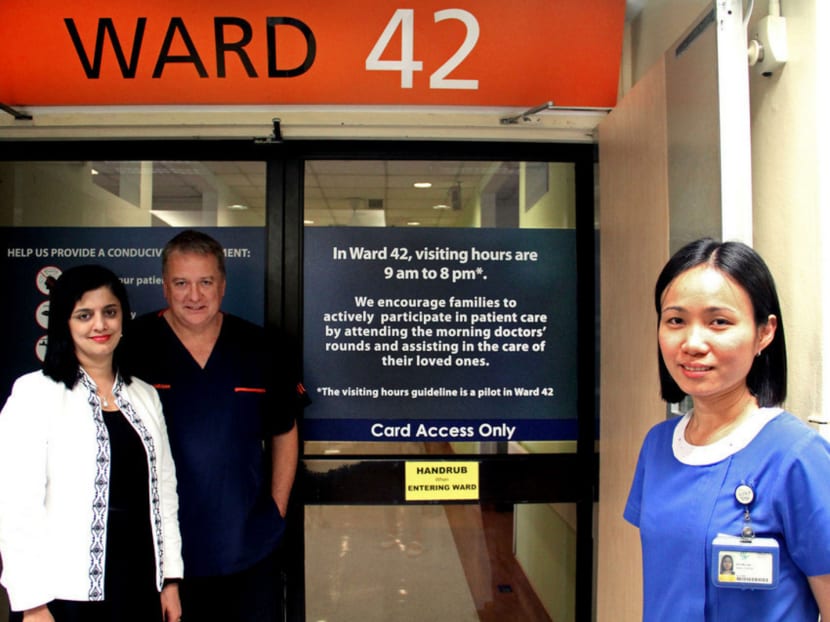Families now get more face time with doctors at hospitals
SINGAPORE — Families of admitted patients may be seen as a hindrance in busy healthcare settings, asking questions that ostensibly slow down the work of doctors and nurses. But some hospitals have recently lowered the barriers standing in the way of communication between doctors and patients’ relatives.

(From left) NUH’s head of general medicine Reshma Merchant, lead clinician of the hospital’s innovation centre Dale Fisher and Ms Koh Mei Jiao, geriatric nurse clinician and nursing champion of NUH’s Ward 42. Photo: Geneieve Teo
SINGAPORE — Families of admitted patients may be seen as a hindrance in busy healthcare settings, asking questions that ostensibly slow down the work of doctors and nurses. But some hospitals have recently lowered the barriers standing in the way of communication between doctors and patients’ relatives.
At least three public hospitals have extended visiting hours, some as pilot projects, so that they overlap with doctors’ ward rounds.
At the National University Hospital (NUH), visiting hours at its innovation centre, the 44-bed Ward 42, were extended to 9am to 8pm last July. The usual hours were noon to 2pm and 5pm to 8pm.
At Tan Tock Seng Hospital (TTSH), 24-hour ward access passes have been given to each patient’s caregiver and spokesperson since March last year for closer engagement with clinical staff. A spokesperson is the point of contact for information on the patient, decisions on procedures and in emergencies.
At KK Women’s and Children’s Hospital, visiting hours of its general wards are from 10am to 8pm, and nurses ending their ward duty would provide updates to patients and their families together with the nurses starting their shift.
“There’s a concept applied by many in the health arena that family gets in the way, slows us down, asks too many questions.
“We don’t believe that. We believe families can help in the care (of the patient), they can inform us as to how the patient’s progressing and … what the home situation is like,” said Professor Dale Fisher, lead clinician of NUH’s innovation centre.
About 1,100 patients have been admitted to Ward 42 since the longer visiting hours were implemented and doctors have found that more decisions get made during ward rounds with the families present.
Face-to-face encounters generate better trust and compliance, facilitating early recovery, said Associate Professor Reshma Merchant, NUH’s head of general medicine.
Nurses have received fewer enquiries from families who are present during ward rounds, said NUH geriatric nurse clinician Koh Mei Jiao.
Ms Grace Chen, whose 88-year-old mother was recently admitted to Ward 42, likes the fact that no special arrangements are needed to speak to the doctors and that one’s entire family may be present to hear from the hospital staff.
Systemic barriers to good doctor-patient communication was an issue flagged nearly two years ago by Singapore Medical Association President Chin Jing Jih. More courses are available to improve the communication skills of doctors, he noted.
However, many complaints are not about a lack of such skills, but barriers that prevent access to doctors, he wrote in the April 2013 issue of the association’s monthly newsletter.
Most doctors do ward rounds from 8am to 11am, but visiting hours in most public hospitals are from noon to 2pm. Associate Professor Chin, a TTSH geriatrician, suggested tweaking the visitor management system and moving meetings between doctors and patients’ families from “a framework based on chance or demand … to an organised system based on appointment-making”.
On why NUH has not implemented its initiatives hospital-wide, Prof Fisher said the impact of the pilot projects would first be measured through satisfaction surveys, feedback from staff and patients and, potentially, statistics on the length of stay and unplanned re-admissions.
“I think to make change, it’s always a two-step process — come up with the idea, develop it, pilot it somewhere and, if successful, then roll it out,” he said.
Longer visiting hours aid in efforts to equip families for the patients’ discharge, the hospitals said.
At Changi General Hospital, families who take advantage of the extended visiting hours of noon to 9pm at its Integrated Building get more opportunities to pick up tips, such as on transferring patients in and out of wheelchairs.
Meanwhile, other hospitals say they have processes in place to ensure families have access to doctors.
At Singapore General Hospital, doctors call or meet families when updates are sought or when the patient’s condition or treatment changes.
Nurses can speak to families at any time and facilitate requests to speak to doctors during ward rounds, said chief nurse Tracy Carol Ayre.






